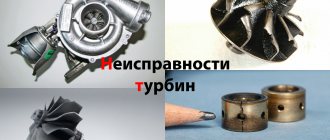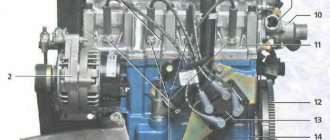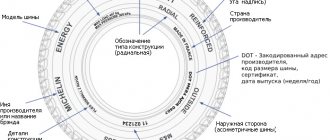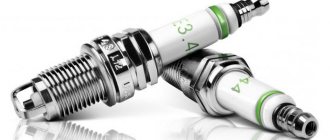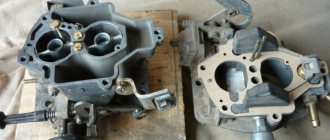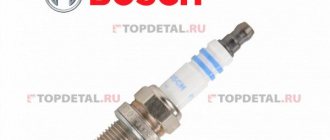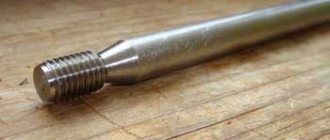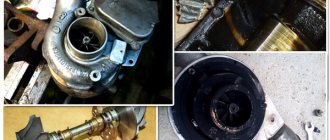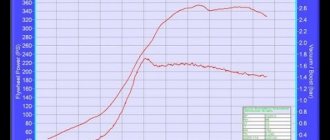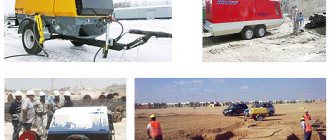Most engines have long been equipped with turbocharging systems. Diesel engines have not been able to operate without turbines for about 20 years, and gasoline engines began the general transition to supercharging 15-10 years ago. With turbines, power units have become faster and more powerful, but car owners have added more hassle. Today we'll talk about what a turbine is, why you need one, and how to choose a good used (used) turbine.
We made a video on the topic of choosing a used turbine, you can watch it on our YouTube channel.
What is a turbine?
In general, this unit is correctly and correctly called a turbocharger. It consists of three main parts. From the turbine housing (“hot” part, enclosed in a cast iron “scroll”), from the compressor housing (“cold” part in an aluminum housing) and the bearing housing located between them (aka “cartridge”). During turbine operation, increased gas pressure is created in the impeller housings, and a vacuum is created in the cartridge.
Inside the cartridge there is a rotor (shaft), at the ends of which the turbine and compressor impellers are attached. Typically, 9 to 12 blades are placed on the impellers. The shaft is mounted on support and thrust bearings, which are bushings in which the shaft is held and rotated. However, today turbines with ball bearings are also becoming widespread.
The turbine bearings must contain oil, which forms an oil wedge on which the turbine rotor rotates - it seems to levitate on a thin layer of oil, slides without resistance and without touching the surface of the cartridge.
Oil is continuously fed into and out of the cartridge. To prevent oil from escaping from the bearing housing into the turbine and compressor housings, steel sealing rings are used. They are cleverly installed - with axial and end clearance. The required compaction is achieved during turbine operation.
How are turbochargers replaced?
Under standard conditions, in the process of replacing a turbocharger, a high-flow compressor and sometimes a turbine impeller with large parameters are installed. This is done in order to achieve the effect of reverse processes, which consists in reducing the force of the exhaust on the work, which leads to a decrease in the speed of their work and the pressure at the beginning of rotation. To pass a larger volume of exhaust for turbines and compressors, a housing with larger parameters is provided.
Some machines are equipped with a turbocharger recommended by the manufacturer, with the correct dimensions of the outlet and inlet passages. Often, motorists prefer “hybrid” ones, which produce power that is different from that provided by standard types of power. Sometimes 180-degree thrust bearings worn out due to increased pressure are replaced with more stable 360-degree analogues.
For economical drivers, an excellent option for replacing turbochargers is to use Japanese used spare parts, the sizes and wide range of which are offered on any car market. In this case, the turbine is selected according to the volume and size of the engine.
How does a turbine work?
The turbocharger is driven by the flow of exhaust gases. The gases spin the turbine impeller, and at the same time the compressor impeller rotates, sucking in air and creating the necessary pressure. A turbocharger's operating range is not unlimited. Thus, if the flow of exhaust gases is insufficient, the performance of the turbine is not high - the boost pressure created is relatively small. But if the engine is “spinned up”, it will begin to produce sufficient exhaust gases, and then the turbine will reach its maximum performance. As people say, “the turbine will turn on.” However, in order for the turbine to always blow, almost from idle, manufacturers use various tricks.
Types of turbines
Turbochargers are:
· single;
· paired (double, triple, quadruple models are available).
They also produce “twin-scroll turbines”, which are installed in passenger gasoline power units and diesel trucks. In such turbines, exhaust gas flows enter 2 separate channels, which eliminates mutual backpressure. As a result, fuel consumption decreases.
In recent years, electrically driven compressors have become widespread, which do not use exhaust gases. The main difference is that the device has a powerful electric motor, which replaces the turbine impellers. There are practically no differences in the compressor part.
How is the turbine controlled?
A turbine is always a compromise solution. For example, for a civilian diesel engine it is important to have good low-end traction. To do this, manufacturers create turbochargers whose rotors spin up to high operating speeds at low engine speeds. But what happens to such a turbine if the driver decides to turn the engine up to the cutoff? In this case, it can reach an prohibitive operating speed, and a so-called “overblowing” will occur, which will not be good for either the turbine itself or the engine. What should I do? Turbine performance needs to be controlled!
The simplest solution is to use a bypass valve (bypass, wastegate). This valve opens when the maximum boost value is reached, and the exhaust gases go through it directly into the exhaust system, bypassing the turbine wheel. Simple, reliable, but not very flexible. A pneumatic actuator is responsible for opening the valve.
A more flexible solution is to control the direction of the exhaust gas flow. To do this, blades are installed in the “snail” of the hot part in the path of the gas flow, the angle of attack of which is adjustable. At low speeds, when there is little gas, the angle of attack of the blades is large: they literally direct and deflect the gases onto the turbine blades. When the boost pressure increases, the engine power and the amount of exhaust gases produced increases, the blades become aligned with the flow of gases, without exerting any directing influence on them. This solution is called “controlled geometry”. A pneumatic drive or an electronic drive with a servomotor is responsible for controlling the position of the blades. The latter is more accurate, but if something happens it is more hassle in terms of repair and calibration.
Let us also mention here that bypass valves are used on turbines of gasoline and diesel engines. And controlled geometry is the domain of diesel engine turbines. Only the opposed turbo-petrol engines of Porsche sportscores use turbines with controlled geometry. The fact is that the temperature of the exhaust gases of gasoline engines is very high and the use of blades with a complex drive mechanism requires the use of expensive heat-resistant alloys.
Also, on high-speed and powerful engines, a bypass valve is used in the intake manifold. It serves to relieve excess boost pressure in cases where, for example, after intense acceleration the driver releases the accelerator (the throttle closes) and the air flow and pressure in the intake is very high. In this case, the air must be bleed, otherwise the load on the compressor impeller and the rotor as a whole will increase critically.
What types of turbines are there?
In addition to the control type, turbines can be divided into several more types. Turbochargers can be single or paired: supercharging can be double, triple and even quadruple (there are such engines). In this case, a very complex layout of the intake and exhaust manifolds, bypass channels of wastegate valves are used to implement staged charging or parallel operation of several turbochargers.
There are also so-called “twin-scroll” turbines. They are used on passenger gasoline engines and diesel trucks. The bottom line is that the exhaust gas flows from the cylinders are collected into two separate channels - to eliminate mutual backpressure and harmonize exhaust gas impulses, ultimately leading to a slight improvement in fuel efficiency. Gases enter the turbine impeller through two channels.
And the latest trend in turbocharger fashion is an electrically driven compressor. That is, the work of exhaust gases is not used. Instead of a turbine impeller, a powerful electric motor is used, powered by a 48-volt power supply. The compressor part is arranged, one might say, in a traditional way.
Turbine numbers
Publication date: 2014-05-06
How to quickly select a turbine? How to find out the turbine number? We tell you the 3 most affordable methods - choose the one that suits you!
Selecting a turbine to replace a failed one is not as simple as it might seem. It requires special knowledge and information. Therefore, it is more reliable to entrust the selection of a turbocharger to a competent seller. The buyer, for his part, can either significantly simplify the seller’s task and reduce the likelihood of error to a minimum, or, conversely, complicate it. It's easy to make life difficult for the seller. To do this, all the buyer’s knowledge about a car with a faulty turbine may be limited to the fact that it has four wheels, a steering wheel and an ashtray. Well, the buyer can help the seller (and, ultimately, himself) in several ways.
Method one (the most reliable)
The identification data necessary and sufficient to find a new turbine can be found on the old one. Usually they are applied to a tag that is attached to the “cold” part of the turbine - the compressor housing; less often - to the bearing housing. Sometimes the markings are engraved directly on the compressor housing area. The buyer’s task is to carefully copy all the information from the tag and report it to the seller. Possible placement options and types of identification tags can be found here
Examples of placement of turbine numbers:
Identification data is printed on the tag. The tag is attached to the “cold” part of the turbine - the compressor housing. Garrett turbine.
Less commonly, the tag is placed on the central bearing housing. Borg Warner Schwitzer turbine.
Less commonly, the tag is placed on the central bearing housing. Garrett turbine cartridge
Sometimes the markings are engraved directly on the compressor housing area. Garrett turbine.
Sometimes the markings are engraved directly on the compressor housing area. Mitsubishi(MHI) turbine.
Like all the best things, this method is not the easiest. If the turbine is dismantled, there is no problem. If it is standing on the engine, difficulties may arise. The turbine is sometimes located in such a way that not only the tag, but also the turbine itself is not easy to find. A lift, a viewing hole, or a mirror on a stick can help. No matter how difficult it is, it’s worth trying, because it guarantees one hundred percent results.
Method two (less hemorrhoids)
You can contact people who have a branded catalog of spare parts for your car and use the VIN number to find out the original number (OE number) of the turbocharger. What kind of people are these? These can be authorized and not so authorized service centers, branded spare parts stores, or simply people who have everything their heart desires. Using the OE number, the turbine seller will find a replacement.
Why is it not enough to provide the VIN number of the car directly to the turbine seller? Because not a single turbo store has original electronic spare parts catalogs for all brands of cars with turbo engines - there are many dozens of them. Turbine sellers use catalogs of turbocharger manufacturers, where turbines are listed under serial numbers, and use so-called cross-catalogs to compare the factory designation with the automaker's OE number.
Method three (the easiest)
To implement it, neither a “mirror on a stick” nor “the help of the audience” is required. It is necessary to first clarify and inform the seller of the turbines the following information (most of it is indicated in the title or registration certificate of the car): make, model and year of manufacture of the car, code (type), displacement and engine power. This method is less reliable than the first two. The reason is that the engine undergoes several design changes during production, which, as a rule, also affect the turbocharging system. It often turns out that different models of turbines and even turbines from different manufacturers were simultaneously installed on engines of the Nth year of production. Only the automaker knows the exact date of release of new engine modifications from the assembly line. Non-original catalogs, which are used to select turbines by car make/model, reflect this information only approximately. Therefore, this method sometimes leads to errors.
In any case, a question like: “Is there a turbine for the Volkswagen Passat?” meaningless - there is no clear answer to it. The more information about the car and engine, the more accurate the answer.
TurboMaster
How to choose a used turbine?
There is a lot of debate about what is better: restoring a turbine or buying a used one. Objectively speaking, a used turbine is about 3 times cheaper than one rebuilt outside the manufacturer. In our catalog, the most expensive used turbine costs 600 rubles, the cheapest – 80 rubles. Yes, the used turbine has some wear. But in its defense, let’s say that turbines not restored at the manufacturer’s factory are equipped with affordable consumables and cartridges from Chinese manufacturers. An original new turbine for popular cars costs from $1,000 to $4,000. Therefore, many, comparing the amounts, also come to the choice of used turbines.
So, what to look for when choosing a turbine? First of all, there should be no rotor play. To do this, we touch the ends of the shaft with our fingers and try to loosen the turbine. There should be no longitudinal axial play (or rather, it should be, but in the range from 0.06 to 0.09 mm - and you cannot feel this with a “finger”). Radial (transverse) play is allowed - this is exactly the gap that is filled by the oil on which the rotor rotates. But under no circumstances should the impellers touch the housing. Also, the blades should not be damaged or chipped. The turbine housings must be dry - without oil drips, which indicate wear and leakage of seals. The cold part snail should generally be dry from the inside. It is also important that the tubes through which oil is supplied to the turbine and drained from it are not just cut, but also rolled (flattened and, as it were, sealed) - in order to prevent dirt from getting into the cartridge.
How is the turbine constructed?
The exact name of this device is a turbocharger. It consists of 3 main parts, namely the housing:
· turbines – hot part;
· compressor – cold part;
· bearing, or cartridge.
The cartridge contains a rotor with turbine and compressor impellers at its ends. On average, the impeller has nine to twelve blades. To secure the shaft, support and thrust bearings (bushings) are used. But now more and more turbines are being produced that use ball bearings.
Bearings need oil: the resulting oil wedge rotates the turbine rotor, which slides over the oil as it rotates. Oil constantly flows into the cartridge and is drained. Oil does not enter the turbine and compressor housings thanks to a clever design - steel O-rings.
